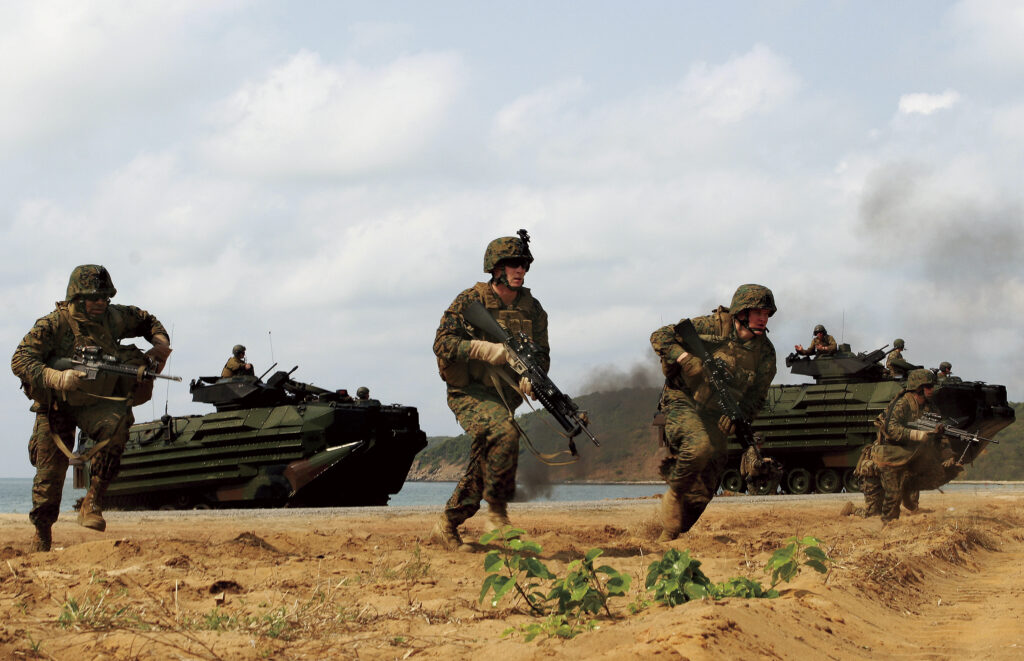
Marines will have to rely on the current Amphibious Assault Vehicle (AAV) to carry them ashore for years to come.
The Marine Corps chose BAE and SAIC from a field of five competitors to build competing prototypes for the long-awaited Amphibious Combat Vehicle. BAE, a dominant player in tracked armored vehicles, had teamed with Italian armsmaker Iveco to offer a variant of the Italians’ wheeled SuperAV. SAIC, best known as a consulting firm, offered a variant of the Singaporean Terrex. “BAE’s contract is for $103.8 million, while SAIC’s is for $121.5 million,” the Marines announced at 5 pm.
The awards are a major step forward for the service. The Marines had struggled for years to replace their Amphibious Assault Vehicle — aging, lumbering, and terribly vulnerable to roadside bombs — whose ability to carry Marines from ship to shore and inland is central to the service’s identity. After early doubts about the ACV candidates’ capabilities, the Marines are now confident the winner will be as fast on the water as the old AAV and vastly better on land, with mobility similar to the Army’s eight-wheel-drive Stryker and — perhaps most importantly — protection equal to an MRAP (Mine-Resistant Ambush-Protected) vehicle.
Each of the two winners will build 16 vehicles to be delivered from January through April 2017. (The current contract says 13 but Marine officials pledge to execute an option for three more once the funding is available). That unusually large number of prototypes will speed up testing and development of tactics, with multiple activities running simultaneously and allowing any broken-down vehicles to be quickly replaced, ACV program manager John Garner told reporters this afternoon. By the time the program enters its formal operational evaluation (OPEVAL) in late 2017 (early fiscal year 2018), said Garner, “the Marines will have already learned how they’re going to operate these vehicles.”
After that comes a downselect to a single winner, who’ll build up to 204 test vehicles at an average procurement unit cost (APUC) of no more than $6.5 million each. That and other costs to date will constitute the $1.2 billion “ACV 1.1” program, which enters service ca. 2021. But immediately on 1.1’s heels comes “ACV 1.2,” which will produce up to 490 vehicles of multiple variants. (All ACV 1.1s are regular troop carriers; ACV 1.2s will also include command vehicles and recovery vehicles, essentially armored tow-trucks). The service wants the transition from 1.1 to 1.2 to be as smooth as possible, with as little new development and testing as possible, which means the winner of 1.1 will have a lock on 1.2 unless they drop the ball.
So why have two iterations at all? Because the Marine Corps wasn’t initially confident industry could quickly develop an affordable vehicle with off-the-shelf components that could also swim from ship to shore. Ship-to-shore self-deployment is an objective for ACV 1.1; it will be a minimum requirement for ACV 1.2. But now the Marines believe industry can meet the ship-to-shore requirement in 1.1.
That’s especially remarkable considering that the program which became ACV wasn’t trying to develop amphibious vehicles. It was called the Marine Personnel Carrier, and it sought an affordable wheeled transport for troops to use on land. But when efforts to build a high-speed Amphibious Combat Vehicle ran aground on questions of complexity, performance, and cost, MPC was rescued from cancellation and given the ACV name. In the process that followed, the Marines took what were reliable, off-the-shelf land vehicles with limited amphibious capability — fording a stream, for example — and focused on teaching them how to swim.
“That is where industry has put a lot of their effort [and] internal research and developing funding, said Garner. “If you were to look at these vehicles now, compared to where we saw them a year and a half, two years ago, the swim capabilities are significant…. We’re comfortable that the vehicles that we’ve selected are going to test out to be very similar to current AAVs.”
This is not the high-speed vehicle the Marines struggled to develop for years. The ideal is essentially a water-skiing tank that could cross vast distances and allow its motherships to stay out of range of shore-based cruise missiles. But widely available missiles can now reach out 65 nautical miles (75 statute miles), making the engineering challenge nigh-impossible.
You can’t solve the 65-knot problem with a single super-vehicle, said Col. Roger Turner, capabilities development director at Marine Corps Combat Development Command. Closing a gap that big takes actual tactics.
“We don’t see that capability being [resident] just in the combat vehicle,” Turner said. “It’s the overall capacity of the joint force, and the naval force, and the Marine Air-Ground Task Force … that will allow us to get in to where we need to get.”
Move over FARA: General Atomics pitching new Gray Eagle version for armed scout mission
General Atomics will also showcase its Mojave demonstrator for the first time during the Army Aviation Association of America conference in Denver, a company spokesman said.


























